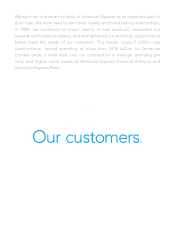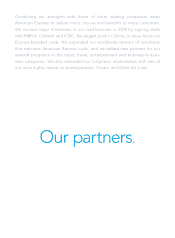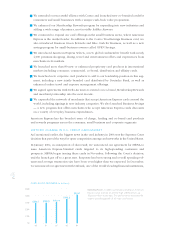American Express 2004 Annual Report Download - page 15
Download and view the complete annual report
Please find page 15 of the 2004 American Express annual report below. You can navigate through the pages in the report by either clicking on the pages listed below, or by using the keyword search tool below to find specific information within the annual report.
During 2004, we announced our first two card-issuing partnerships with major U.S. banks —
MBNA and Citibank. Ultimately, we expect to partner with a range of banks in the U.S.
— small, medium and large institutions. Some issuers will convert specific, high-spending
segments of their customer base onto our network, while others will add American Express-
branded cards to their product portfolio to attract new affluent customers. I will discuss our
GNS strategy — both in the newly opened U.S. market and internationally, where GNS is
an established success story with 87 partnerships in 98 countries — in greater detail later
in this letter.
Our network business is only one of the expanded opportunities for American Express. We
are excited about the rapidly growing area of prepaid services, which offers tremendous
potential to capture spending that would otherwise go to cash and checks. We are also
making strong progress in growing our Corporate Middle Market business, a largely
untapped and growing segment of the corporate travel and expense management market.
Joint Ventures and Acquisitions: Because we have been consistently able to generate strong
growth from within our business, we have not had to rely on acquisitions to sustain our
revenue growth. Instead, we have taken a highly selective approach to acquisitions, pursuing
only those opportunities that can enhance our capabilities and accelerate growth in core
lines of business.
We did not make any major acquisitions in 2004. Rather, we focused on successfully inte-
grating two significant ones from 2003 — Threadneedle Asset Management Holdings Lim-
ited, a leading U.K. investment management firm, and Rosenbluth International, one of the
most respected companies in the travel management industry. Both have exceeded our
expectations in terms of business performance and integration.
Increasing Profitability:Revenue growth is important, but profitable growth is the ultimate
barometer of success. We have devoted a great deal of energy over the past four years to
improving the economics of our business. As a result, we have seen consistent increases
in return on equity and a stronger balance sheet. We also have an attractive risk/return pro-
file compared to others in our industries.
Reengineering has played a key role in improving our profit margins and freeing up
resources to invest in growth. In 2004, we delivered more than $1 billion in reengineering
benefits for the fourth year in a row. Our pre-tax margin improved to 17.0 percent from
16.4 percent a year ago.
We consider reengineering to be a critical and ongoing aspect of our management strategy
at American Express. We focus on making core processes more efficient by reducing costs
while increasing quality. In fact, much of our savings from reengineering now come from
Six Sigma quality improvement projects. As an example, in our U.S. cardmember servicing
network we used Six Sigma and other tools to significantly improve our already high cus-
tomer satisfaction results while reducing unit costs in 2004. We will continue to focus
intensely on reengineering, being careful not to lose our sense of urgency despite our
excellent financial performance.
AXP
AR.04
—
13
























